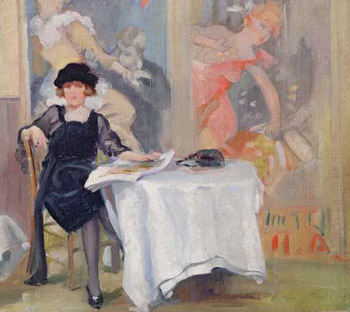Objections
Where Does the Catechism Say that Immodest Clothing for Women Is Mortal Sin?
TIA responds:
V.S.,Unfortunately what was once understood as included in the 6th Commandment must today be explicitly set out, because Catholic preachers are silent on the topic and we have become accustomed to immodest clothing.
Only few priests today preach against this sin, and thus most of the faithful continue to be led astray by following the modern day styles, which are extremely immodest, even for children.
1. Sins against the 6th Commandment
We direct you to a trustworthy Catechism Explained by Spirago and Clark's to find good Catholic Moral doctrine to be applied to immodest clothing (Francis Spirago and Richard Clark, The Catechism Explained: An Exhaustive Exposition of the Christian Religion, with Special Reference to the Present State of Society and the Spirit of the Age, originally pub. in 1899; repub. by TAN Books and Publishers, Inc. 1993, pp. 390-391). On this topic it reads:
“The 6th Commandment of God
“1. In the Sixth Commandment almighty God prohibits everything that might stain our own purity or that of our neighbor. God more especially forbids. ...

Cabaret & burlesque shows, immodesty in theater with women purposely enticing men
"Those who dress immodestly are the Devil’s instruments for the ruin of souls. Vanity and love of dress are powerful factors in Satan’s service; for women who deck their person to attract men dare not presume to say that they are chaste and pure of heart; their very appearance gives them the lie. The longing for admiration does not come from a simple heart; it is a snare to entrap others into vice (pp. 392-393).”
In the same Catechism, mortal sin is explained: “Commits a mortal sin he who consciously and of his own free will does grievous dishonor to God or wrong to his neighbor in a weighty matter; who does injury to his own life, or to the life, the property, or the reputation of his neighbor (p. 458).”
The Catechism supposes that dressing immodestly is a mortal sin when it is done in full knowledge in a way that arouses impure desires in others and with the intention to sin in this way.
2. Saints & Popes who condemn immodest clothing
This doctrine is confirmed by Saints when they issued warnings saying that dressing immodestly constitutes a grievous sin:
St. Clement of Alexandria, in The Instructor, book II, chap. II
"By no means are women to be allowed to uncover and exhibit any part of their bodies, lest both fall – the men by being incited to look, and the women by attracting to themselves the eyes of men."

A woman tempts a man in dance
“You carry your snare everywhere and spread your nets in all places. You allege that you never invited others to sin. You did not indeed, by your words, but you have done so by your dress and your deportment. … When you have made another sin in his heart, how can you be innocent?
"Tell me, whom does this world condemn? Whom do judges punish? Those who drink poison or those who prepare it and administer the fatal potion? You have prepared the abominable cup, you have given the death dealing drink, and you are more criminal than are those who poison the body; you murder not the body but the soul.
"And it is not to enemies you do this, nor are you urged on by any imaginary necessity, nor provoked by injury, but out of foolish vanity and pride.” (Immodesty Satan’s Virtue, quoted by Rita Davidson)
St. Thomas More in The Four Last Things, Chap. 8:
‘Louis of Granada speaks of a young woman whose damnation had no other source than vanity and the desire to please. She led a regular life, but her passion to attract attention by the charm of her beauty was the moving cause of her whole conduct. Having fallen sick, she died, having received all the Sacraments.
"While her confessor was praying for her soul, she appeared to him, saying that she was damned, and that the cause of her damnation was vanity. 'I sought,' she added, 'only to please the eyes of men. This passion caused me to commit a multitude of sins; it prevented me from receiving the Sacraments well, and it has led me to everlasting torments.'"
Pope Pius XII, on August 15, 1954, delegated Cardinal Ciriaci to issue a letter on modesty in which he explicitly declares it a mortal sin to dress immodestly:
“Everyone knows that during the summer months particularly, things are seen here and there which are certain to prove offensive to anyone who has retained some respect and regard for Christian virtue and human modesty. On the beaches, in country resorts, almost everywhere, on the streets of cities and towns, in private and public places, and, indeed, often in buildings dedicated to God, an unworthy and indecent mode of dress has prevailed.

Immodesty in posture & attitude
"Feminine adornment, if it can be called adornment, feminine clothing, ‘if that can be called clothing which contains nothing to protect either the body or modesty,’ (Seneca) are at times of such a nature that they seem to serve lewdness rather than modesty. What we are discussing here is obviously most serious, since it vitally concerns not only Christian virtue but also the health and vigor of human society. Well, did not the ancient poet say of this matter: ‘Vice necessarily follows upon public nudity’?…
"A mortal sin of scandal is committed by women who go about with their bosom immodestly exposed, or who expose their limbs improperly. Also by actors in immodest comedies, and still more by the persons who compose such comedies; also by painters who paint obscene pictures, and by the heads of families who keep such pictures in their houses.
"The father who speaks obscenely, or blasphemes the saints, in presence of his children, and the mother who brings into her house to live among her daughters young men who are in love with them, or betrothed to them, or other suspected persons, are guilty of a still more grievous sin of scandal.

The provoking ‘changing tents’ in the 1930s temporarily covered the exposed bodies - the next step was the bikini
"There was a woman who, even after marriage, did not cease giving scandal. This woman one day fell into a fit, and while she was in a state of unconsciousness, she saw the Lord condemning her to eternal fire. When she recovered the use of her senses, she did nothing but cry out, 'Alas! I am damned, I am damned!'
"A confessor came to comfort her, but she answered, 'What have I to do with confession? I am damned.' Then her daughter approached the bed, in order to encourage her, but she cried out: 'Ah, accursed child! on your account, too, I am damned: for through you I have given scandal to others.' After these words the devils, in presence of all who were in the apartment, raised her up to the ceiling, and then dashed her so violently against the floor that she instantly expired."
These are several - among many - examples of how the Church, speaking through a Pope and Saints, has traditionally taken the sin of immodesty very seriously.
We hope that this doctrine responds sufficiently to your challenge to prove that that women who wear immodest clothing commit mortal sin.
Cordially,
TIA correspondence desk

Posted June 7, 2022
______________________

______________________
______________________






















Laudetur Jesus Christus
In this article, you are writing that If we go to a catechism, we learn that for women to wear immodest clothing is a mortal sin. Can you, please, guide me where exactly is it written?
Thank you,
S.V.